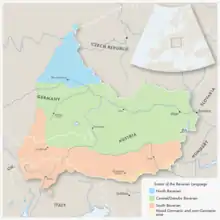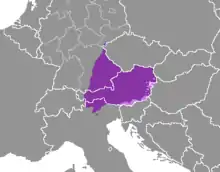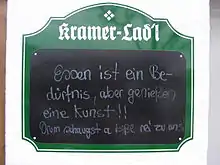Bavarian language
Austro-Bavarian (also known as Bavarian German, Austrian or Bavarian; Boarisch [ˈbɔɑ̯rɪʃ] or Bairisch; German: Bairisch [ˈbaɪ̯ʁɪʃ] (![]() listen)) is a major group of Upper German varieties spoken in the southeast of the German language area, much of Bavaria, most of Austria and South Tyrol in Italy, as well as Samnaun in Switzerland.[2] Before 1945, Austro-Bavarian was also prevalent in parts of the southern Czech Republic and western Hungary. Bavarian forms a continuum of more or less mutually intelligible local and regional variants. Its mutual intelligibility with Standard German is very limited, but most of its speakers can code-switch to Standard German.
listen)) is a major group of Upper German varieties spoken in the southeast of the German language area, much of Bavaria, most of Austria and South Tyrol in Italy, as well as Samnaun in Switzerland.[2] Before 1945, Austro-Bavarian was also prevalent in parts of the southern Czech Republic and western Hungary. Bavarian forms a continuum of more or less mutually intelligible local and regional variants. Its mutual intelligibility with Standard German is very limited, but most of its speakers can code-switch to Standard German.
| Austro-Bavarian | |
|---|---|
| Boarisch, Bairisch | |
| Pronunciation | German [baɪʁɪʃ] Bavarian [bɔarɪʃ] |
| Region | Austria, Bavaria, and South Tyrol |
| Ethnicity | Austrians Bavarians South Tyroleans |
Native speakers | 14,000,000 (2016)[1] |
| Language codes | |
| ISO 639-3 | bar |
| Glottolog | baye1239 Bairischbava1246 Bavarian |
 Extent of the Austro-Bavarian language | |
Austro-Bavarian has been listed as an "individual language" in the ISO 693-3 standard.[3]
History
The Bavarians as a group formed in the early medieval period, as the population of the Duchy of Bavaria, forming the south-eastern part of the kingdom of Germany. The Old High German documents from the area of Bavaria are identified as Altbairisch ("Old Bavarian"), even though at this early date there are few distinctive features that would divide it from Alemannic German.
The dialectal separation of Upper German into East Upper German (Bavarian) and West Upper German (Alemannic) becomes more tangible in the Middle High German period, from about the 12th century.
Geographical distribution and dialects

- In Europe:
- In Bavaria, the language is spoken in Upper Bavaria, Lower Bavaria, and the Upper Palatinate;
- In Austria, except Vorarlberg and Reutte;
- In Italy in South Tyrol and a handful of linguistic enclaves of Cimbrian and Carnic people in Northern Italy;
- In Switzerland, it is spoken in the village of Samnaun, in Grisons;
- In Sopron (Hungary) and surroundings.
- Outside of Europe:
- In Treze Tílias, Brazil
- In Pozuzo, Peru
- In the United States and Canada
Three main dialects of Austro-Bavarian are:
- Northern Bavarian, mainly spoken in Upper Palatinate, but also in adjacent areas (small parts of Upper Franconia (Wunsiedel (district) and Bayreuth (district)), Saxony (southern Vogtland), Middle Franconia, Upper Bavaria and Lower Bavaria).
- Central Bavarian along the main rivers Isar and Danube, spoken in Upper Bavaria (including Munich, which has a standard German speaking majority), Lower Bavaria, southern Upper Palatinate, the Swabian district of Aichach-Friedberg, the northern parts of the State of Salzburg, Upper Austria, Lower Austria, Vienna (see Viennese German) and the Northern Burgenland.
- Southern Bavarian in Tyrol, South Tyrol, Carinthia, Styria, and the southern parts of Salzburg and Burgenland.
Differences are clearly noticeable within those three subgroups, which in Austria often coincide with the borders of the particular states. For example, each of the accents of Carinthia, Styria, and Tyrol can be easily recognised. Also, there is a marked difference between eastern and western central Bavarian, roughly coinciding with the border between Austria and Bavaria. In addition, the Viennese dialect has some characteristics distinguishing it from all other dialects. In Vienna, minor, but recognizable, variations are characteristic for distinct districts of the city.
Before the expulsion of Germans from Czechoslovakia, the lingustic border of Bavarian with Czech was on the farther side of the Bohemian Forest and its Bohemian foreland was Bavarian-speaking.
Use

In contrast to many other varieties of German, Bavarian differs sufficiently from Standard German to make it difficult for native speakers to adopt standard pronunciation. All educated Bavarians and Austrians, however, can read, write and understand Standard German, but they may have very little opportunity to speak it, especially in rural areas. In those regions, Standard German is restricted to use as the language of writing and the media. It is therefore often referred to as Schriftdeutsch ("written German") rather than the usual term Hochdeutsch ("High German" or "Standard German").
School
Bavaria and Austria officially use Standard German as the primary medium of education. With the spread of universal education, the exposure of speakers of Bavarian to Standard German has been increasing, and many younger people, especially in the region's cities and larger towns, speak Standard German with only a slight accent. This accent usually only exists in families where Bavarian is spoken regularly. Families that do not use Bavarian at home usually use Standard German instead. In Austria, some parts of grammar and spelling are taught in Standard German lessons. As reading and writing in Bavarian is generally not taught at schools, almost all literate speakers of the language prefer to use Standard German for writing. Regional authors and literature may play a role in education as well, but by and large, Standard German is the lingua franca.
Literature
Although there exist grammars, vocabularies, and a translation of the Bible in Bavarian, there is no common orthographic standard. Poetry is written in various Bavarian dialects, and many pop songs use the language as well, especially ones belonging to the Austropop wave of the 1970s and 1980s.
Although Bavarian as a spoken language is in daily use in its region, Standard German, often with strong regional influence, is preferred in the mass media.
Ludwig Thoma is a noted author who wrote works such as Lausbubengeschichten in Bavarian.
Web
There is a Bavarian Wikipedia, completely in Bavarian. Also, the official FC Bayern Munich website is available in Bavarian.[4]
Phonology
Consonants
| Bilabial | Labio- dental |
Alveolar | Post- alveolar |
Palatal | Velar | Glottal | |
|---|---|---|---|---|---|---|---|
| Nasal | m | n | ŋ | ||||
| Stop | p b | t d | k ɡ | (ʔ) | |||
| Affricate | p͡f | t͡s | t͡ʃ | ||||
| Fricative | f v | s | ʃ | (ç) | x | h | |
| Trill | r | ||||||
| Approximant | l | j |
Notes:
- The phoneme /h/ is frequently realised as [ç] or [x] word-internally and is realised as [h] word-initially.
- Intervocalic /s/ can be voiced to [z].
- A trill sound /r/ may also be realised as a tap sound [ɾ].
- Intervocalic /v/ or /w/ sound can be realised as [ʋ] or [β, w].
- Some dialects, such as the Bavarian dialect in South Tyrol, realise /k/ as an affricate [k͡x] word-initially and before /m, n, l, r/, which is an extension of the High German consonant shift to velar consonants.
Vowels
Vowel phonemes in parentheses occur only in certain Austro-Bavarian dialects or only appear as allophones or in diphthongs. Nasalization may also be distinguished in some dialects.
| Front | Central | Back | |||
|---|---|---|---|---|---|
| unrounded | rounded | ||||
| Close | i | y | u | ||
| Near-close | ɪ | ʏ | ʊ | ||
| Close-mid | e | ø | (ə) | o | |
| Open-mid | ɛ | œ | (ɐ) | ɔ | |
| Open | (æ) | a | (ɑ) | ɒ | |
Bavarian has an extensive vowel inventory, like most Germanic languages. Vowels can be grouped as back rounded, front unrounded and front rounded. They are also traditionally distinguished by length or tenseness.
Grammar
The commonly accepted grammar and spelling system for Bavarian has been documented by A. Schmeller;[5] see more details at the German Wikipedia page for Bairische Dialekte.
- Bavarian usually has case inflection only for the article. With very few exceptions, nouns are not inflected for case.
- The simple past tense is very rare in Bavarian and has been retained for only a few verbs, including 'to be' and 'to want'. In general, the perfect is used to express past time.
- Bavarian features verbal inflection for several moods such as indicative, subjunctive and imperative. See the table below for inflection of the Bavarian verb måcha, 'make; do':
| måcha | Indicative | Imperative | Subjunctive | Optative |
|---|---|---|---|---|
| 1. Sg | i måch | — | i måchad | måchadi |
| 2. Sg (informal) | du måchst | måch! | du måchast | måchast |
| 3. Sg | er måcht | er måch! | er måchad | måchada |
| 1. Pl | mia måchan* | måchma! | mia måchadn | måchadma |
| 2. Pl | eß måchts | måchts! | eß måchats | måchats |
| 3. Pl | se måchan(t) | — | se måchadn | måchadns |
| 2. Sg (formal) | Si måchan | måchan’S! | Si måchadn | måchadn’S |
Personal pronouns
| Singular | Plural | ||||||
|---|---|---|---|---|---|---|---|
| 1st person | 2nd person informal | 2nd person formal | 3rd person | 1st person | 2nd person | 3rd person | |
| Nominative | i | du | Si | ea, se/de, des | mia | eß/öß / ia* | se |
| Unstressed | i | -- | -'S | -a, -'s, -'s | -ma | -'s | -'s |
| Dative | mia | dia | Eana | eam, eara/iara, dem | uns, ins | enk / eich* | ea, eana |
| Unstressed | -ma | -da | |||||
| Accusative | -mi | -di | Eana | eam, eara/iara, des | uns, ins | enk / eich* | ea, eana |
| Unstressed | Si | -'n, …, -'s | -'s | ||||
* These are typically used in the very northern dialects of Bavarian.
Possessive pronouns
| Masculine singular | Feminine singular | Neuter singular | Plural (any gender) | ||||
|---|---|---|---|---|---|---|---|
| Nominative | mei | meina | mei | meine | mei | mei(n)s | meine |
| Accusative | mein | ||||||
| Dative | meim | meina | meim | ||||
The possessive pronouns Deina and Seina inflect in the same manner. Oftentimes, nige is added to the nominative to form the adjective form of the possessive pronoun, like mei(nige), dei(nige), and the like.
Indefinite pronouns
Just like the possessive pronouns listed above, the indefinite pronouns koana, "none", and oana, "one" are inflected the same way.
There is also the indefinite pronoun ebba(d), "someone" with its impersonal form ebb(a)s, "something". It is inflected in the following way:
| Personal | Impersonal | |
|---|---|---|
| Nominative | ebba | ebbs |
| Accusative | ebban | |
| Dative | ebbam | |
Interrogative pronouns
The interrogative pronouns wea, "who", and wås, "what" are inflected the same way the indefinite pronoun ebba is inflected.
| Personal | Impersonal | |
|---|---|---|
| Nominative | wea | wås |
| Accusative | wen | |
| Dative | wem | |
Society
Bavarians produce a variety of nicknames for those who bear traditional Bavarian or German names like Josef, Theresa or Georg (becoming Sepp'l or more commonly Sepp, Resi and Schorsch, respectively). Bavarians often refer to names with the family name coming first (like da Stoiber Ede instead of Edmund Stoiber). The use of the article is considered mandatory when using this linguistic variation. In addition, nicknames different from the family name exist for almost all families, especially in small villages. They consist largely of their profession, names or professions of deceased inhabitants of their homes or the site where their homes are located. This nickname is called Hausname (en: name of the house) and is seldom used to name the person, but more to state where they come from or live or to whom they are related. Examples of this are:
- Mohler (e.g. Maler – painter)
- Bachbauer (farmer who lives near a brook)
- Moosrees (Resi who lives near a brook)
- Schreiner (joiner)
Samples of Bavarian and Austrian
| Austrian | 's Bóarische is a Grubbm fő Dialektt im Siin fåm dætschn Shbroochråm. |
|---|---|
| Bavarian | 's Bóarische is a Grubbm fő Dialektt im Siin fóm daitschn Shproochraum. |
| Yiddish (Southeastern) | בײַריש איז אַ גרופּע פֿון דיאַלעקטן אין דרום פֿון דײַטשיש שפּראַך־קאָנטינום
Bairish iz a grupe fin dialektn in durem fin daitshish shprakh-kontinuum. |
| Standard German | Das Bairische ist eine Gruppe von Dialekten im Süden des deutschen Sprachraumes. |
| English | Bavarian is a group of dialects in the south of the German Sprachraum. |
| Austrian | Sérawas*/Zéas/D'Ere/Griass Di/Griass Gód, i bĩ da Beeder und kumm/kimm fõ Minchn/Minicha. |
|---|---|
| Bavarian | Sérwus/Habedéare/Griass Di/Griass Gód, i bin/bĩ da Peeder und kimm fő Minga/Minka. |
| Yiddish (SE) | שלום־עליכם, איך בין פּיטר און קום אױס מינכן
Shulem aleikhm, akh bin Piter in kim oys Minkhn. |
| Standard German | Hallo/Servus/Grüß dich, ich heiße Peter und komme aus München. |
| English | Hello, I am Peter and I come from Munich. |
| Austrian | D'Lisa/'s-Liasl hod sé an Haxn bróchn/brócha. |
|---|---|
| Bavarian | D'Lisa/As Liasal hod sé an Hax brócha. |
| Yiddish (SE) | ליסע/ליסל האָט זיך איר/דאָס/אַ בײן געבראָכן
Lise/Lisl hot zikh ir/dus/a beyn gebrokhn. |
| Standard German | Lisa hat sich das Bein gebrochen. |
| English | Lisa broke/has broken her leg. |
| Austrian | I ho(b)/hã/hoo a Göd/Goid gfundn/gfunna. |
|---|---|
| Bavarian | I ho(b) a Gejd/Goid/Göld gfuna. |
| Yiddish (SE) | איך האָב (עפּעס (אַ ביסל)) געלט געפֿונען
Akh hob (epes (a bisl)) gelt gefinen |
| Standard German | Ich habe Geld gefunden. |
| English | I (have) found money. |
The dialects can be seen to share a number of features with Yiddish.[6]
References
- Austro-Bavarian at Ethnologue (18th ed., 2015)
- "Bavarian". Ethnologue. Retrieved 2017-08-31.
- "Documentation for ISO 639 identifier: bar".
- https://fcbayern.com/by
- Schmeller, Johann Andreas; edited by Frommann, Georg Carl (1872). https://opacplus.bib-bvb.de/TouchPoint_touchpoint/start.do?SearchProfile=&Query=205%3D%22BV025305704%22&Language=De. München, Oldenbourg 2002. ISBN 3-486-52603-0.
- Weinreich
Further reading
- Dictionary
- Hietsch, Otto (2015), Wörterbuch Bairisch-Englisch, Von Apfelbutzen bis Zwickerbusserl, Regenstauf: SüdOst Verlag, ISBN 978-3-86646-307-3
- Philology
- Schikowski, Robert (2009), Die Phonologie des Westmittelbairischen
- Wiesinger, Peter, The Dialects of Modern German: A Linguistic Survey, pp. 438–519
- Egon Kühebacher (1965–1971). Tirolischer Sprachatlas. 3 Vol.: Vokalismus, Konsonantismus, Sprachatlas. (= Deutscher Sprachatlas. Regionale Sprachatlanten. Hg. von Ludwig Erich Schmitt, Karl Kurt Klein, Reiner Hildebrandt, Kurt Rein. Bde. 3/1–3). Marburg: N. G. Elwert Verlag.
External links
| Bavarian edition of Wikipedia, the free encyclopedia |
![]() Media related to Bavarian language at Wikimedia Commons
Media related to Bavarian language at Wikimedia Commons